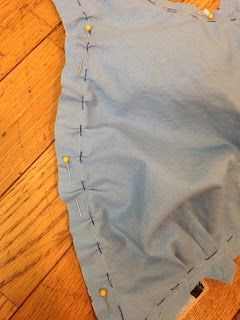My grandmother passed away in April of 2014. She taught me how to knit and continually inspired me to keep at my other fiber related passions. She was also a great sewer and quilter. When she passed I got one of her sewing machines and I've been happily sewing on it since then. I also got first dibs of going through her stash. Grandma was not the fiber snob that I am, and she had very difference taste in colors than me, but I still managed to bring two large totes worth of fabric home with me. One of the fabrics that I picked out was an adorable vintage cotton with strawberries and leaves printed on it. I picked it out intending to make kitchen curtains out of it, for like a hot minute when I saw the yardage I had visions of a full skirted 50s style dress, but common sense prevailed and I made curtains.
I faced several challenges while designing my curtains. The first was that my lease states that I cannot hang curtain rods. Fortunately, my windows have nice deep frames so using a pressure rod instead is not a problem, but it does sort of dictate the look of the curtains.
Secondly, my windows are relatively small, 41"x45" on the inside of the frame. Because I can't use curtain rods I can't use curtains to visually change the size of the window, so I needed a curtain design that wouldn't visually overwhelm the window.
Thirdly my strawberry fabric is only 36" wide, but the muslin that I was using to line it (also out of my stash) was the now more common 44" wide. I let the strawberry fabric dictate the width of my curtains, and got a little creative with the lining on the back, working on the basis that I'll never really have to look at the back of the curtains.
I decided to let the width of my fabric largely dictate the design. Because it's so narrow I didn't want to make two panels of curtains, I felt the window would end up looking overwhelmed. So I cut three panels of my strawberry fabric 50" long and sewed them together with a 1/2" seam allowance to get one panel 106" wide by 50" long. My mom taught me that curtains should be between two to three times the width of the window. Twice the width can look a little bare, but three times can be overwhelming on narrower windows. My curtains are almost exactly 2.5 times the width of the window.
Isn't the fabric cute? Anyway, then needed to make a lining so I cut two 44"x50" panels out of the muslin, then one 19"x50" piece, then I had to sort of piece together the remaining muslin to get a second 19"50" piece. I then sewed all of those together to get a second rectangle 106" wide.
From the right side, I don't think my Frankenstiened lining is that noticeable, and when it's hung no one can see it.
Then I put my fabrics right side together and sewed around the right, bottom, and left sides, leaving the top of the curtains open. I turned the fabric right side out and very carefully pressed the edges. I used a knitting needle to poke out the corners to get them nice and square. I wanted to make sure that only the strawberry fabric was visible from the right side so I actually turned it about 1/16" in towards the back, instead of trying to press right down the middle of the seam.
So when I top-stitched the edges from the wrong side you can see just a little bit of the strawberry fabric.
And from the right side you can't see the lining at all.
Then I sewed the curtain rod pocket. To do that I turned down and pressed about 1/2" of the top, then I turned it over and pressed down about 2.5" and sewed the channel.
Next, I cut two more rectangles from the strawberry fabric, this time 6"x36" to act as ties for the curtains.
Because I chose to make only one panel instead of two, but I also like symmetry, I decided to attach the ties to the top of the curtain and use the to tie the curtain up instead of to the left or right.
I sewed the rectangles into a tube using a 1/2" seam allowance, turned it right side out and pressed it. I chose to press the seam to the center instead of the side so it would look prettier from the front.
I then top-stitched all the way around and sewed a buttonhole on one side of each of them and sewed the button to the other. The cute pink buttons also came from my grandmother's stash.
I carefully centered the ties over the two seams on the front of the curtains from sewing my original panels together, then I sewed the tie down following the stitched from sewing the curtain rod pocket. Had I thought about it in advance I think I would have sewed the ties on at the same time I made the pocket, but I was careful enough that I think you have to be looking closely to see where the doubled stitching is.
I think it drapes beautifully when hung, and the button is a cute, subtle detail.
And here is my finished curtain, hung in the window and looking rather adorable if I do say so myself.
I am really happy with the final product. The red in it goes well with all the other red accents in my kitchen without being too overwhelming. I think it makes my kitchen look more "finished" and because the fabric was all out of my grandmother's stash it didn't cost me a dime, and now I will think of her whenever I look at my window. It sure beats our charming view of the parking lot.



































